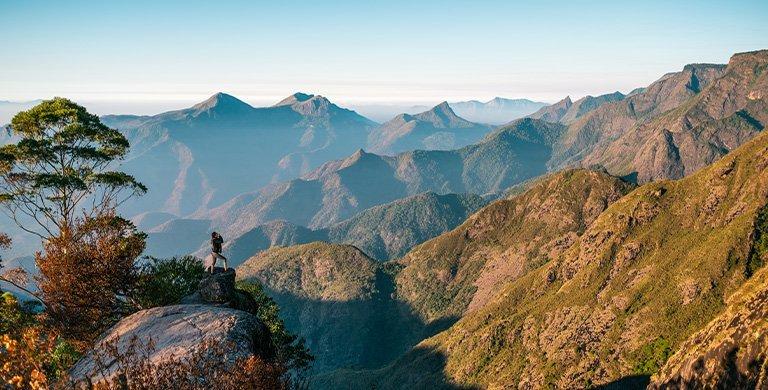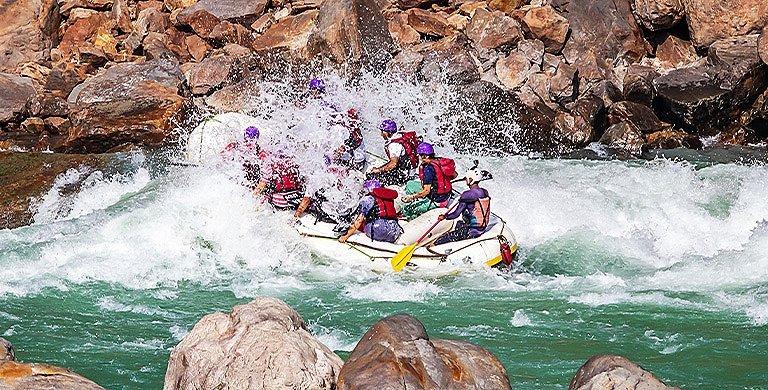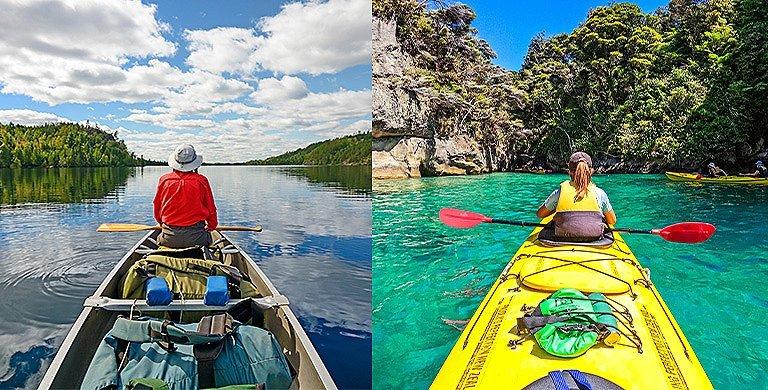
OUTDOOR LIFE
Handling Fear and Risk in the Outdoors
BY: NANCY BOUCHARD
“Without the risk of failure, there is no potential for greatness.”
Reinhold Messner
Outdoor activities can be scary. It might be hiking solo, crossing a ridge, forging a creek, dropping a couloir—or just trying something totally new. Outdoor adventure risk management and fear management strategies go hand in hand. You analyze the risk, then confront the fear that comes with it.
You don’t start at the edge of your ability. You build up—both in skill and in your ability to assess risk. No one jumps straight into ice climbing, mountaineering, hiking the PCT or heli skiing big-mountain lines. It’s baby steps. For climbing and mountaineering, start with a gym or a via ferrata. For a thru-hike, build endurance, experience, and backcountry skills with shorter trips. With skiing, you start at local hills and work your way to the backcountry steeps. And yes, even the baby steps can be dangerous—but over time, your decision-making sharpens, and your ability to stay calm under pressure improves.
Fear isn’t just for elite athletes; it shows up any time you’re pushing your limits. After years of talking to top performers, people who manage real risk for a living, one thing is clear: how you handle fear depends on the goal, the type of fear, and whether it’s rational or not. However, preparation is everything. You train, plan, and run worst-case scenarios. And when the moment comes, if conditions are right, you commit. But always with backup plans, including the option to walk away. There’s no shame in waiting for another day, in fact backing off of an objective is a skill the best outdoor athletes have mastered. Seasoned experts say that handling fear isn’t about ignoring it. It’s about listening to it, and responding with focus, skill, and strategy. Most outdoor pursuits carry risk. That’s part of the deal. The goal isn’t to be fearless, it’s to be ready.
A critical piece of this readiness is situational awareness, being fully attuned to the environment, terrain, weather conditions, and even the people around you. This can be stranger-danger, or situations where an avalanche, rockfall or plain reckless behavior can ruin your day. Awareness like this helps sharpen your risk assessment and decision-making in the moment.
That’s something freestyle skier Alex Ferreira understands all too well. The X Games champ, Olympic medalist, and Columbia ambassador has spent years performing at the edge of what’s possible. “If you’re not a little bit scared, something’s definitely wrong with you,” he says, laughing, but he means it. Fear keeps him grounded and honest, especially in a sport where the line between a medal run and a crash is razor thin. Ferreira approaches big contests like the X Games or Olympics with intense nerves—he’s dry-heaved before dropping in—but he relies on structure to minimize fear’s impact. His daily routine includes meditation, physical training, and visualization. He also relies on constant positive self-talk, “I got this,” on repeat, to build mental resilience. Fear doesn’t disappear, it becomes manageable. Even after brutal crashes, Ferreira knows when to step back and reset—like returning to powder skiing at Aspen Highlands to reconnect with the joy of the sport. His advice to anyone leveling up their outdoor game is take it slow, think it through, and don’t rush the big stuff. “There’s always another day. Just really think before you do.”
You don’t start at the edge of your ability. You build up—both in skill and in your ability to assess risk. No one jumps straight into ice climbing, mountaineering, hiking the PCT or heli skiing big-mountain lines. It’s baby steps. For climbing and mountaineering, start with a gym or a via ferrata. For a thru-hike, build endurance, experience, and backcountry skills with shorter trips. With skiing, you start at local hills and work your way to the backcountry steeps. And yes, even the baby steps can be dangerous—but over time, your decision-making sharpens, and your ability to stay calm under pressure improves.
Fear isn’t just for elite athletes; it shows up any time you’re pushing your limits. After years of talking to top performers, people who manage real risk for a living, one thing is clear: how you handle fear depends on the goal, the type of fear, and whether it’s rational or not. However, preparation is everything. You train, plan, and run worst-case scenarios. And when the moment comes, if conditions are right, you commit. But always with backup plans, including the option to walk away. There’s no shame in waiting for another day, in fact backing off of an objective is a skill the best outdoor athletes have mastered. Seasoned experts say that handling fear isn’t about ignoring it. It’s about listening to it, and responding with focus, skill, and strategy. Most outdoor pursuits carry risk. That’s part of the deal. The goal isn’t to be fearless, it’s to be ready.
A critical piece of this readiness is situational awareness, being fully attuned to the environment, terrain, weather conditions, and even the people around you. This can be stranger-danger, or situations where an avalanche, rockfall or plain reckless behavior can ruin your day. Awareness like this helps sharpen your risk assessment and decision-making in the moment.
That’s something freestyle skier Alex Ferreira understands all too well. The X Games champ, Olympic medalist, and Columbia ambassador has spent years performing at the edge of what’s possible. “If you’re not a little bit scared, something’s definitely wrong with you,” he says, laughing, but he means it. Fear keeps him grounded and honest, especially in a sport where the line between a medal run and a crash is razor thin. Ferreira approaches big contests like the X Games or Olympics with intense nerves—he’s dry-heaved before dropping in—but he relies on structure to minimize fear’s impact. His daily routine includes meditation, physical training, and visualization. He also relies on constant positive self-talk, “I got this,” on repeat, to build mental resilience. Fear doesn’t disappear, it becomes manageable. Even after brutal crashes, Ferreira knows when to step back and reset—like returning to powder skiing at Aspen Highlands to reconnect with the joy of the sport. His advice to anyone leveling up their outdoor game is take it slow, think it through, and don’t rush the big stuff. “There’s always another day. Just really think before you do.”

Cassie Sharpe takes a similar approach, but with her own twist. The Columbia ambassador, who’s won Olympic and X-Games gold, has faced her share of high-consequence moments on snow. For her, fear isn’t something to avoid, it’s something to work with. “You need that fear to make sure you’re staying within your limits,” she says. Whether she’s competing in the halfpipe or chasing big lines in the backcountry, Sharpe doesn’t try to shut fear out. She uses it, channeling that nervous energy to stay sharp, alert, and honest with herself about where the edge really is. Her personal risk strategy is simple: if something feels off, it probably is. Trust your gut, follow the right progressions, and don’t rush the process. Since becoming a mother, her go-for-it mindset hasn’t disappeared, but she’s more intentional than ever. “I just make sure I’m following the correct progressions to minimize risk,” she says. It’s not about holding back, it’s about showing up smart, grounded, and fully in the moment. And, as Sharpe can attest, risk assessment changes overtime, because situations are always changing, like parenthood. “Now that I have a child, I want to prove I’m back,” Sharpe admits. “But I also think having my daughter change my priorities, my risk and reward has shifted.” It’s a reminder that fear isn’t just a feeling, it’s a signal to reassess, recalibrate, and move forward with purpose.
But fear doesn’t always announce itself with nerves. For Columbia ambassador and NASCAR driver Bubba Wallace, managing fear isn’t about calming jitters, it’s about trusting the years of prep that kick in when everything, including his 23XI Racing Team Toyota Camry, goes sideways. “Generally, I’m kind of a no-fear person,” he says. “I just do it and enjoy the thrill.” But that doesn’t mean fear doesn’t show up. Wallace still remembers the moment his brakes failed at Pocono in 2018, a full-speed crash that reminded him just how real the risks are. Still, racing doesn’t leave much room for hesitation; when things go wrong, there’s no time to think—only to react. “You work on everything you were taught,” he says. “You rely on it.” With two Cup Series wins and a career built on consistency and resilience, Wallace knows that overanalyzing can shut you down faster than a blown tire. His approach? Stay ready, live fully, and don’t let fear do the driving. “You’ve just got to do it. Period,” he says.
Mark Daniels Jr., professional angler and Columbia ambassador, points to a different kind of fear and risk that comes with outdoor sports, conflict with strangers. “Since we fish public waters, there are times when you might have a negative encounter, on the water, on a dock, with an angry homeowner,” he says. “In those moments, things can get heated. I do my best to avoid those scenarios, and when I can, I try to de-escalate. But sometimes, people just want to argue or fight. When that happens, I try my best not to engage.” It’s a reminder that managing fear and risk isn’t always about the environment or the sport itself. It’s also about navigating the unpredictable social side of outdoor adventures.
“The appeal of the outdoors partially rests on its unpredictability. You’re not spending time in the backcountry because it’s just like another day at the office,” says Michael Bane, author of TRAIL SAFE, a landmark book on being safe in the backcountry and who himself lives off-grid in rural Colorado. “I approach meeting ‘challenging’ people on the trail the same way I do in international travel, polite, more than willing to apologize, happy to change my behavior. There are certainly red lines than can’t be crossed, seriously dangerous events, but those are much fewer and farther between than most people think."
But fear doesn’t always announce itself with nerves. For Columbia ambassador and NASCAR driver Bubba Wallace, managing fear isn’t about calming jitters, it’s about trusting the years of prep that kick in when everything, including his 23XI Racing Team Toyota Camry, goes sideways. “Generally, I’m kind of a no-fear person,” he says. “I just do it and enjoy the thrill.” But that doesn’t mean fear doesn’t show up. Wallace still remembers the moment his brakes failed at Pocono in 2018, a full-speed crash that reminded him just how real the risks are. Still, racing doesn’t leave much room for hesitation; when things go wrong, there’s no time to think—only to react. “You work on everything you were taught,” he says. “You rely on it.” With two Cup Series wins and a career built on consistency and resilience, Wallace knows that overanalyzing can shut you down faster than a blown tire. His approach? Stay ready, live fully, and don’t let fear do the driving. “You’ve just got to do it. Period,” he says.
Mark Daniels Jr., professional angler and Columbia ambassador, points to a different kind of fear and risk that comes with outdoor sports, conflict with strangers. “Since we fish public waters, there are times when you might have a negative encounter, on the water, on a dock, with an angry homeowner,” he says. “In those moments, things can get heated. I do my best to avoid those scenarios, and when I can, I try to de-escalate. But sometimes, people just want to argue or fight. When that happens, I try my best not to engage.” It’s a reminder that managing fear and risk isn’t always about the environment or the sport itself. It’s also about navigating the unpredictable social side of outdoor adventures.
“The appeal of the outdoors partially rests on its unpredictability. You’re not spending time in the backcountry because it’s just like another day at the office,” says Michael Bane, author of TRAIL SAFE, a landmark book on being safe in the backcountry and who himself lives off-grid in rural Colorado. “I approach meeting ‘challenging’ people on the trail the same way I do in international travel, polite, more than willing to apologize, happy to change my behavior. There are certainly red lines than can’t be crossed, seriously dangerous events, but those are much fewer and farther between than most people think."
Risk. Fear. Focus. What Elite Athletes Know About Staying Sharp
I’ve been an extreme sport athlete for several decades, and here are some things I’ve learned from some of the world’s biggest risk takers.

Handling Risk in the Outdoors
- Respect the Risk — But Don’t Let It Own You
Every serious outdoor athlete knows that if you’re not thinking about what could go wrong, you probably should be. But obsessing over it will freeze you. The goal is balance—to understand risk deeply enough to approach it with skill and strategy, not denial or fear. As one extreme skier put it, “You build up not only your skill level, but your ability to assess risk.” “You don’t jump into free soloing or big mountain skiing overnight—it’s baby steps.” - Preparation is Power
Real preparation goes beyond fitness. It’s mental conditioning, scenario planning, visualizing worst-case outcomes, and building backup strategies. As one mountaineer said, “When it’s go-time, if the conditions are right, I commit—but always with backup plans, including the option to walk away.” Risk feels less threatening when you’ve done the hard work in advance. - Use a Personal Decision Framework
Having a clear go/no-go mindset is vital. One athlete explained how they mentally dissect a big objective into parts—if each part gets a green light, they move forward. This kind of analysis grounds the decision in logic, not adrenaline or external pressure. The ability to say “not today” might be the most underrated skill in outdoor sports.

Handling Fear in Outdoor Sports
- Fear Is Not the Enemy — It’s a Signal
Fear sharpens, focuses, warns. “Fear is the only emotion that will turn you into a survival machine,” one skier/wingsuit flyer said.” But it only works if you don’t ignore or suppress it. Fear is a companion, not a curse. Learn to read what it’s telling you.” - Let It Move Through You
Instead of bottling it up, let fear flow. “I used to ignore it and put it in a box,” an extreme athlete said. “But that made me weaker and less aware.” Feeling fear fully—the racing heart, the tension, the doubt—and still choosing to act is mastery. You’re not fearless. You’re fluent in fear. - Anchor Yourself in the Present
Fear pulls you into the future—what if I fall? What if I fail? The most grounded athletes return to the moment. Use techniques like breath as your anchor. - Confidence Is Safer Than Hesitation
Tentativeness on a steep descent, tight turn, or edge of a jump is what gets people hurt. “You’re generally safer when you’re on the offense—that is, confident and decisive,” one Olympian said. ”If you’re nervous but prepared, you have to let go of the emotions and focus on doing your best. Sometimes accidents happen, but being present helps you go through your checklist—tuck and roll, stay loose, protect your head.” A relaxed body absorbs shock better. - Channel Your Emotions — Don’t Suppress Them
Fear, anxiety, pressure, even ego—they’re not flaws. They’re fuel, if you know how to channel them. “Emotions can either help you or hurt you. It just depends on how well you can wield them,” said another world-class athlete. “Emotional intelligence is a critical athletic skill.” - Familiarity Breeds Functionality
All fears become more navigable through exposure. “You learn to live with it, and that makes life more vivid,” another athlete said. “Facing real danger regularly brings intimacy with fear that turns it from abstract into something you can manage and respect.” - Fear Changes, Not Disappears
With time and experience, fear morphs. It might go from full-blown panic to a subtle hum, then to a check-in. It’s never gone, but it becomes a manageable background noise, a signal, not a stop sign. - Develop a System
Many legendary risk-sport athletes rely on time-honored mental tools to stay sharp when it matters most. Two of the most effective? Learning to zoom out when fear starts to tunnel your vision and resetting your response in real time. The OODA loop—Observe, Orient, Decide, Act—is a tactical mindset used to break out of reactive thinking. By observing your environment and orienting to the full situation, you avoid getting locked into a narrow view. As one outdoor adventurer put it, “People tend to get super focused on one specific thing. The trick is to step back and look at your surroundings.” When fear hits mid-adventure, many also use the STOP method: Stop, Take a breath, Observe, and Proceed. It’s a pause-and-reset routine that clears the mental clutter and helps you move forward with purpose, not panic. Neither method is about eliminating fear—they’re about not letting it run the show. - Use a Smart App
An app can provide valuable information to enhance your outdoor experience. The GOES Health app lets you know what to expect ahead of time and be prepared for most any occurrence. The app was developed to help individuals find information for on-the trail medical emergencies, but it also provides other handy details about weather forecasts, poisonous plant identification, and even how to tell the difference between a black bear and grizzly. The outdoor app works offline so you can handle any unexpected situation. For limited time, Columbia’s Greater Rewards program’s Titanium members get a free 3-month GOES+ premium subscription.
Sign up For Greater Rewards - Columbia Sportswear
Sign up for Greater Rewards form Columbia Sportswear. Earn Points and enjoy Free Shipping.
Sign up for Greater Rewards form Columbia Sportswear. Earn Points and enjoy Free Shipping.

Risk and Fear are part of the wild, and part of being human. Your goal isn’t to vanquish it—it’s to move through it, learn from it, and keep going with your eyes wide open. Whether you’re just starting out or chasing world-class feats, remember, respect the risk, prepare like hell, and listen to what your fear is telling you. It’s not about being risk free but prepared for whatever you’re facing. Get outside. Take the next step. And when fear shows up, remember, you’ve got this.
The next time you’re out there pushing your limits, bring Columbia’s apparel, footwear and accessories. We won’t be there to hold your hand, but we will keep you warm, dry, and comfortable—so the only thing you’re sweating is your next move.



